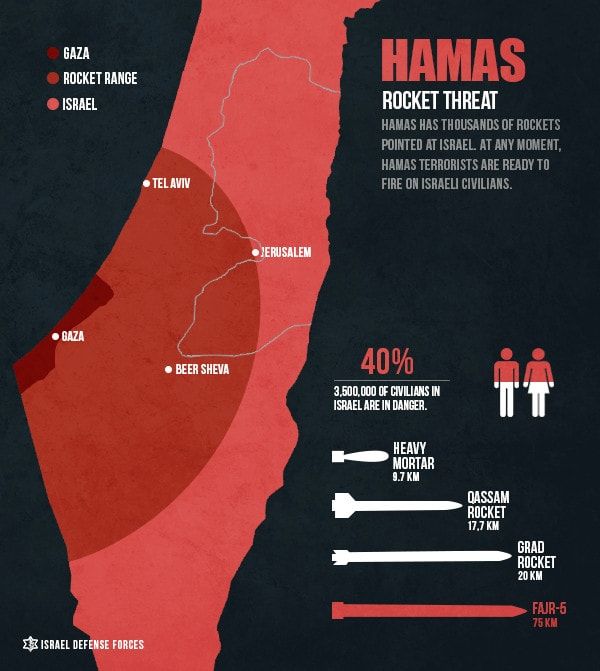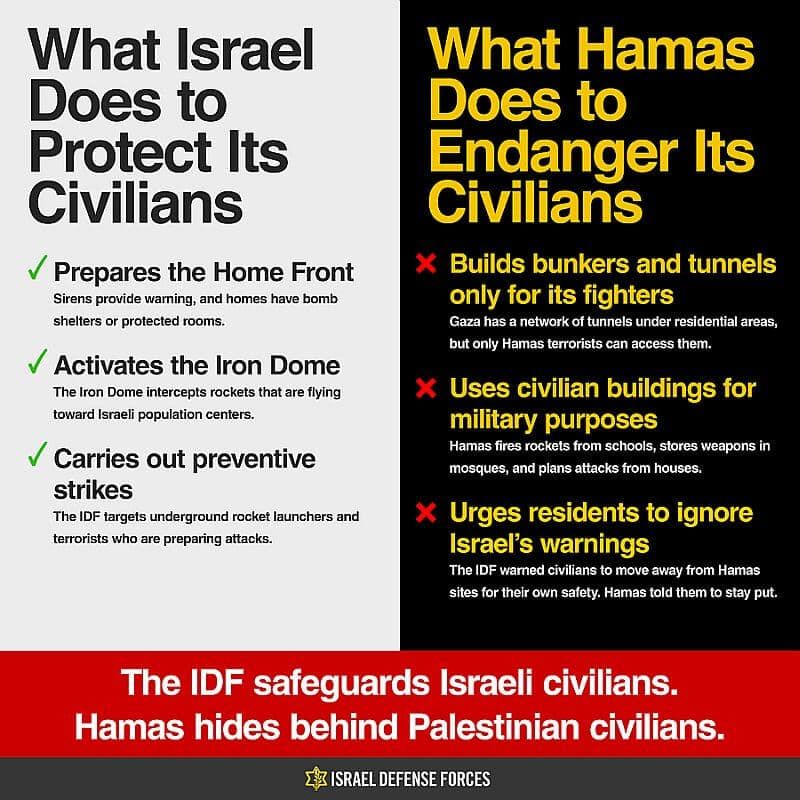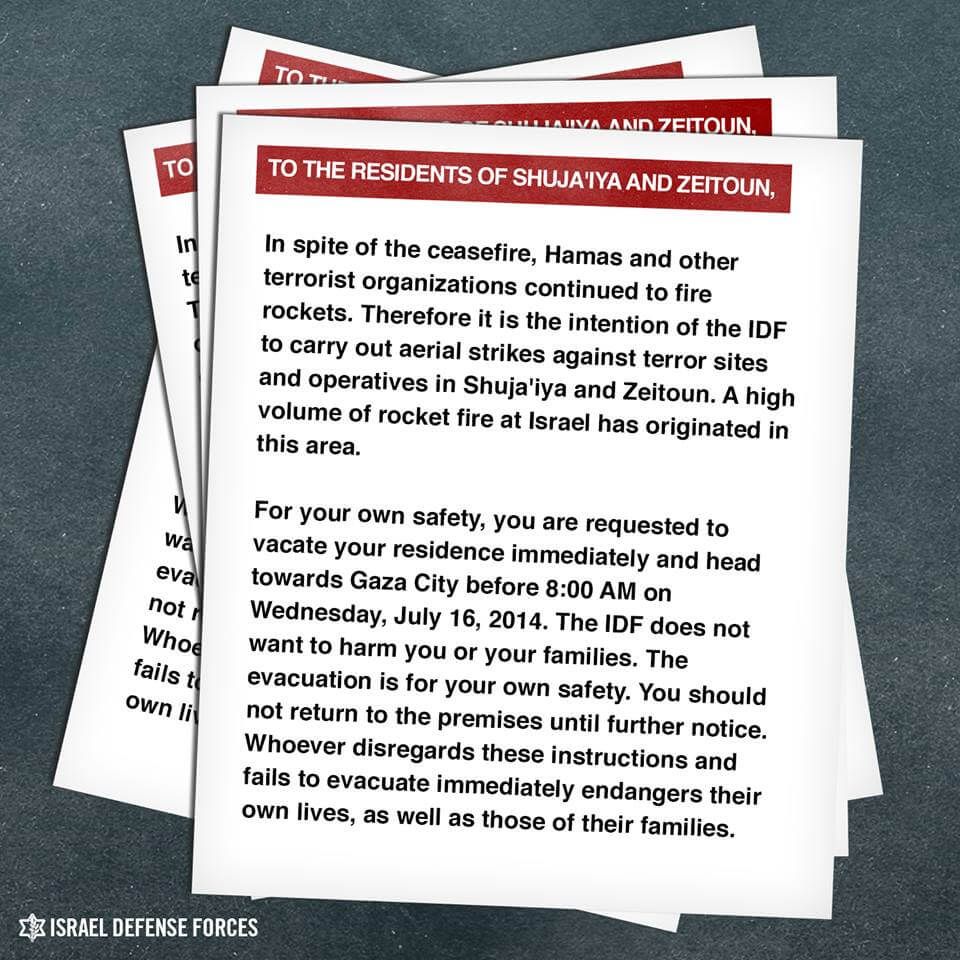There have been three significant Gaza wars since 2008 that have caused immense damage not only to the Gaza Strip but also to Israel’s image as the international media and UN agencies routinely blame the country for launching military operations and for the humanitarian crises there.
But the context, explaining why Israel has no choice but to carry out operations leading to full-blown wars in Gaza, and the reasons why Gazan civilian casualties are so high, is generally omitted.
And that’s a travesty because that background changes the entire story particularly as the constant threat of another Gaza war continues to loom large.
BACKGROUND
The Gaza Strip, a territory on the eastern coast of the Mediterranean Sea, bordering Egypt on its southwest for 11 kilometers and Israel to its east and north for 51 kilometers, was controlled by Egypt until 1967. During the Six Day War in June 1967, Egyptian forces shelled the Israeli cities near Gaza with heavy ammunition. Israel had no choice but to engage Gaza in war to protect its own citizens from the Egyptian bombardment and sure enough, once Israel entered, the bombardment stopped.
Following the war, Israel made it clear that its forces would leave the Gaza Strip in exchange for peace. The Arab leadership – including Egypt – replied with the “three noes,” leaving Israel in control of the Gaza Strip and its more than one million Arab inhabitants.
In August 2005, Israel moved all its forces out of the Gaza Strip and forced 9,000 Israelis who had settled there, to move out of the Strip. The idea was to give the Palestinian Authority a chance to run its own geographic area with zero Israeli interference. Israel left its greenhouses in Gaza for the Gazan people to benefit from and the platform was created for the Palestinians to establish a free and prosperous society.
Join the fight for Israel’s fair coverage in the news
LEAD-UP TO WAR WITH GAZA
However, from 2005 to 2007, with no IDF forces there to stop them, Palestinian terrorists fired 2,700 locally made Qassam rockets into Israeli cities from the Gaza Strip.
Aside from the actual damaged caused when missiles land in residential areas, rocket attacks from Gaza on Israeli cities mean that innocent civilians – including women and children – have just 15 seconds to find cover from the moment warning sirens sound until rocket impact. This means that Israelis had to run for cover an average of 2 ½ times per day during this period of time. No child should have to grow up living with such terror and no government can allow its citizens to suffer in this manner.

Then in June 2007, Hamas, an internationally recognized terror organization that promotes the destruction of Israel in its charter, took control of the Gaza Strip. Israel had no choice but to impose a ground, air and water blockade to make sure that Hamas did not import advanced weapons to be used against Israel, while making a clear public declaration that humanitarian supplies would be allowed into the Strip. Hamas increased the rocket fire and Israel responded with air attacks against Hamas targets.
Despite various attempts at ceasefires, the Hamas rocket attacks against Israel continued.
In the fall of 2008, Israeli intelligence discovered that Hamas was digging tunnels to be used for terrorists to sneak into Israel and abduct IDF soldiers. In fact, one such tunnel had earlier been used to kidnap IDF soldier Gilad Shalit in 2006. (Shalit was held by Hamas for five years and was only freed in exchange for Israeli freeing over 1,000 terrorists from its prisons.)
Israel launched Operation Double Challenge on November 4, 2008 – a cross border military raid in the Dayr al-Balah neighborhood – just 300 meters from the Gaza Strip border in order to destroy the tunnel which began under a residential building. A gun battle started between Hamas and the IDF and Hamas pledged “revenge for Israeli aggression.” Hamas then fired over 200 rockets into Israel cities over the course of the next month. In response, Israel closed the crossings into Gaza.
Israeli leaders determined that the only way to stop the Hamas rocket fire on Israeli cities was to launch an operation to eliminate the rockets, the Hamas infrastructure and the Hamas leadership.
Related reading: The Gaza Blockade: An Explainer
THE FIRST GAZA WAR: OPERATION CAST LEAD
On December 27, 2008 Israel launched “Operation Cast Lead.” Israeli airstrikes destroyed Hamas headquarters and government offices and killed hundreds of Hamas militants. The IDF also targeted homes of Hamas commanders which served as weapons warehouses and military headquarters, and killed many high-ranking Hamas commanders.
Israel called the commanders beforehand in order to make sure that their families would not be hurt but they did not always heed these warnings or prevented family members from leaving, and many were killed with the commanders. Some Hamas leaders hid in the basements of the Shifa Hospital complex in Gaza City, using the hospital patients as human shields against Israeli attacks.

Colonel Richard Kemp, former commander of British forces in Afghanistan told the United Nation Human Rights Council that during this operation
the Israel Defense Forces did more to safeguard the rights of civilians in a combat zone than any other army in the history of warfare
and that Palestinian civilian casualties were a consequence of Hamas’ method of fighting – using human shields and deliberately sacrificing their own civilians.
Kemp added that Israel took extraordinary measures to notify civilians of targeted areas and that Israel even aborted important missions to prevent civilian casualties.
The IDF sent two million leaflets warning of specific targets that were going to be attacked. The air force also contacted residents of buildings where Hamas leaders were hiding, which were used for weapons storage, or from which rockets were launched against Israel – notifying them that they had 10-15 minutes to flee before the attacks. Some attacks had to be called off when the residents responded to the warnings by gathering on the roof of the building.
The United Nations Security Council issued a statement on December 28, in which it called for “an immediate halt to all violence.” Similar demands were made by the European Union and the Arab League.
Israel determined that the only way to avoid killing massive numbers of Palestinian civilians while successfully destroying the rockets which were being launched from heavily populated areas and eliminating more Hamas leaders who were hiding among the civilian population, was to put its own soldiers at great risk and enter the Gaza Strip with ground troops. The ground offensive began on January 3, 2009 with IDF troops entering Beit Lahiya and Beit Hanoun – going after 40 sites including rocket launch sites and weapons storehouses. The IDF also targeted Hamas militants – killing almost all of the 100-man “Iranian Unit” who were trained by the Iranian Revolutionary Guard in Iran.
Related reading: Focus on Hamas: A Brutal Terror Organization
CEASEFIRE
Israel faced significant international pressure to agree to a ceasefire due to the deteriorating humanitarian situation in Gaza and because of the number of civilian casualties, despite Israel’s best efforts to avoid them.
Israel opened a humanitarian corridor on January 7, 2009 to allow the shipment of aid into Gaza. Israel also agreed to three-hour humanitarian ceasefires either daily or every other day. Hamas fired 44 rockets and mortars at Israel during these humanitarian ceasefires.
On January 9, the United Nations Security Council passed Resolution 1860 calling for “an immediate, durable, and fully respected cease-fire” with a goal for Israel to fully withdraw from the Strip and Hamas to end its arms smuggling.
Israel announced a two-phased unilateral ceasefire on January 17. Israel committed to pull its forces out of Gaza if the rocket fire stopped and made it clear that if the rocket fire would continue then Israeli forces would go back in. Rocket fire continued during that day but on January 18, Hamas agreed to stop firing rockets for a week and demanded that Israel withdraw its forces from the Strip within a week and open all crossings. The last IDF soldiers left Gaza on January 21.
THE AFTERMATH
Following the war, Gaza found itself in dire straits. Thousands of homes and hundreds of public buildings were destroyed. Over 200 roads and bridges were severely damaged alongside ten water and sewage lines. Estimates placed the damage at $2 billion. 1,166 Gazans were killed during the war, 295 of who were confirmed to be civilians.
Israel lost ten soldiers in battle and three civilians from Hamas rocket fire. 1,500 Israeli homes and vehicles were destroyed. But Israel achieved nearly all of its military objectives. 80% of the tunnels between Gaza and Egypt, used to smuggle in rocket parts and weapons, were destroyed. Hamas lost many of its primary leaders and soldiers, and its capacity to fire rockets into Israel was greatly reduced.
In addition, Hamas was forced to focus on rebuilding its infrastructure and winning back the support of the Gazan public – forcing it to suspend shooting rockets into Israel which was Israel’s number one objective in the operation. In the year leading up to the war, Hamas fired 3,300 rockets into Israeli cities. In the ten months following the war, fewer than 300 were fired – not removing the danger but making life more bearable for the 700,000 innocent Israelis living within missile range of the Gaza Strip, who found themselves in an impossible situation of constant rocket fire in the months leading up to the war.
Israel faced significant condemnation from the United Nations – especially its Goldstone Report – and from various humanitarian agencies. Most focused on the civilian casualties and the humanitarian disaster on the Gazan side.
Related reading: Gaza and the UN’s Goldstone Report
THE SECOND GAZA WAR: OPERATION PILLAR OF DEFENSE
The rocket fire never ceased completely. 680 rockets were fired on Israel in 2011 and 797 were fired from the beginning of 2012 until November 13 – including 171 rockets or mortars in October alone, and 80 in one day on October 24. On November 13, over 100 rockets were fired from Gaza into Israeli cities in just 24 hours. Israel responded on November 14 by killing Ahmed Jabari, the chief of the Hamas military wing, in an air strike on his car in Gaza. That began Operation Pillar of Defense, during which Israel destroyed more than 1,500 sites in the Gaza Strip including missile launching sites, weapon storage houses, and Hamas government facilities.

During the operation, Hamas and other Gazan terror groups fired 1,456 rockets at Israeli cities. But they didn’t use only the Qassams and mortars that were used in the past but upgraded to firing Iranian made Fajr-5 and Russian made Grad rockets which reached well beyond the cities near the Gaza Strip and hit Rishon LeZion and Tel Aviv in the center of Israel.
Israel’s new Iron Dome missile defense shield intercepted 421 of the rockets. The Iron Dome, along with Israel’s improved ability to strike terrorists while in the act of launching rockets, the addition of bomb proof rooms in all Israeli homes, and the new Red Alert warning system, kept Israeli casualties to a minimum. Six Israelis were killed and close to 250 injured from the Gazan rocket fire.
On the Palestinian side, 177 were killed, 120 of them were members of terror organizations. Hamas and other terror groups launched missiles next to mosques, schools, playgrounds and hospitals, making it very challenging for Israel to destroy the launchers while avoiding civilian casualties. In fact, the UN Office of the High Commissioner for Human Rights released a report in March 2013, criticizing the Palestinian groups for failing “to take all feasible precautions in attacks, in particular launching rockets from populated areas which put the population at grave risk.”
A ceasefire was mediated by Egypt on November 21, 2012 after Israel felt that it achieved its goal of crippling Hamas’s rocket launching apparatus, without having to enter Gaza with ground troops.
The result was “just” 55 rocket attacks during 2013. But by 2014, the rocket attacks resumed and increased to 85 rocket attacks on Israeli cities in the first five months of 2014.
Related reading: Debunking the ‘Disproportionate Force’ Charge
THE THIRD GAZA WAR: OPERATION PROTECTIVE EDGE
In June 2014, Hamas members kidnapped and murdered three Israeli teenagers. (It should be noted that Israel foiled around 60 kidnapping attacks in the year leading up to this successful kidnapping.) Israel killed the kidnappers and arrested Hamas operatives who were involved in the terror attack, leading Hamas to bombard Israel with missiles. From June 12 to July 5, 117 rockets were fired from Gaza into Israeli cities, and Israel responded with approximately 80 airstrikes against Hamas targets in Gaza.
Israel offered a ceasefire to Hamas, who insisted that it would only hold its fire if Israel released all Hamas prisoners arrested for the kidnapping. Israel refused and warned Hamas that it would have no choice but to engage in an extensive operation.
On July 7, Israel killed seven Hamas operatives who were working on digging a tunnel into Israel to enable terrorists to carry out cross-border attacks, and in response Hamas fired 40 rockets at Israeli cities. The next day, Israel launched Operation Protective Edge to, once again, eliminate the threat of missile fire from Gaza. During the operation, Israel discovered the existence of tens of already dug terror tunnels – some which Hamas terrorists used to sneak into Israel – and had no choice but to begin a ground offensive in Gaza on July 17.
Throughout the operation, there were numerous “humanitarian” ceasefires to allow for the Gazan population to receive their most basic needs. Due to the inability of Gaza hospitals to treat their wounded, Israel established an IDF field hospital at the Erez Crossing between Gaza and Israel in order to provide medical care for Gazans. Hamas, however, prevented its own population from receiving treatment there.
A US-UN brokered ceasefire was announced on August 1, and on August 3 Israel withdrew most of its ground forces from Gaza. The IDF had attacked 5,263 terror targets in Gaza (1,814 rocket/mortar launch sites, 191 weapon factories and warehouses, 1,914 Hamas command and control centers, 237 government institutions which supported terror activity, and hundreds of military outposts in buildings), destroyed 2/3 of the 10,000 strong rocket-arsenal of Hamas, and destroyed 34 terror tunnels.
During the fighting, 4,564 rockets and mortars were fired at Israeli cities with 735 intercepted by the Iron Dome missile defense shield. 67 Israeli soldiers and five Israeli civilians were killed during the operation. The economic damage to Israel was estimated at $2.5 billion.
Over 2,000 Gazans were killed and the cost to rebuild the damage in the Strip was estimated at 4-6 billion dollars. 273,000 Gazans were displaced due to Hamas firing rockets from residential areas – including weapons storage and terror tunnels originating in UN facilities! – and the ensuing Israeli attacks to destroy the launchers and eliminate the terrorists.
Navi Pillay, the UN High Commissioner for Human Rights, accused Hamas of violating international law by “locating rockets within schools and hospitals, or even launching these rockets from densely populated areas.” The European Union also criticized Hamas for its “calls on the civilian population of Gaza to provide themselves as human shields.” Amnesty International reported that “Hamas spokespeople reportedly urged residents in some areas of the Gaza Strip not to leave their homes after the Israeli military dropped leaflets and made phone calls warning people in the area to evacuate.”

Israel was criticized strongly by the UN and humanitarian organizations for its military operation.
The international community pledged $5.4 billion in order to reconstruct the Gaza Strip. Hamas has been accused of taking most of these funds to rebuild its terror infrastructure. Arne Gericke, a member of the European Parliament said, “It would sicken most (European) taxpayers to know that the EU itself could be directly contributing to the tragic cycle of violence.”
WHAT CHANCE IS THERE FOR AN END TO WAR WITH GAZA?
Israel, like any other country, cannot tolerate rocket fire into its cities. It allows hundreds of trucks per day to bring humanitarian needs into Gaza. However, it maintains the blockade of Gaza in order to prevent weapons from entering into the hands of its enemies who continue with their declaration and determination to destroy Israel and has no choice but to destroy missile launching sites and neutralize those responsible for them. If Hamas would change its charter and not call for Israel’s annihilation, and cease to fire rockets and organize terror attacks in Israel, the blockade could be fully lifted, and Israel could live in peace with its neighbors in the Gaza Strip.
Liked this article? Follow HonestReporting on Twitter, Facebook, Instagram and TikTok to see even more posts and videos debunking news bias and smears, as well as other content explaining what’s really going on in Israel and the region.
New! Skip the social scroll and get the latest from HonestReporting via Telegram.

